|
by Errol Smith - Brisbane, Australia. |
G'day Chuck. Here is the article about the trilars/trikye. I have sent it also to Jim Michalak along with a query if he would design me a larger version. He seems willing to, so I'll follow that up. I have also sent this article to the Australian Boatbuilder Magazine here in Australia. Must go, the wind is starting to freshen up, 15/20 knots, so I'll slip into the harbour and show off the lilac coloured Trikye. Just love the favorable comments that I get. - Errol
The Trikye came into being through a desire to expand on my couple of years of building kayaks during my "alleged" retirement. I had never considered building a sailing boat until a mate of mine moved interstate and presented me with a complete mast and rig for a Hartley 16. I stored the gear down the back yard and forgot about it. For a month or two at least.
During that time I had finished building a West River 180 kayak for myself.
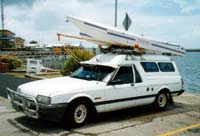 |
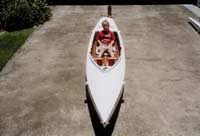
|
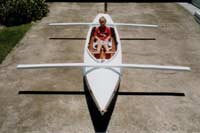
|
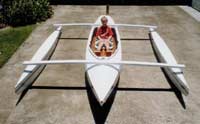 |
|
The craft had to be modular for easy assembly and lightweight enough for me to be able to lift it up atop my panel van.
(click images for larger views) |
|
After that, I developed this feeling of being at a loose ends and realized that what Ross Lillistone wrote in his last article about boat building being addictive is true. He also wrote that one should start by building a smaller craft before embarking on the building of the dream.
The problem was what to build? I didn't fancy hanging out the side of a small monohull or a small catamaran racer. Then I remembered reading that some designer had written that one should think about what one wanted to do with a boat. Well I had this vision of floating peacefully around Moreton Bay; reclining back in something stable that wouldn't upset my glass of wine.
| I had this vision of floating peacefully around Moreton Bay; reclining back in something stable that wouldn't upset my glass of wine. |
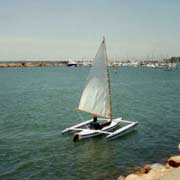
|
|
That left maybe a standard cat or a tri. But which one to chose? Both had advantages and disadvantages. The answer came one day as I was paddling back to the harbour after a cruise to Green Island in the West River 180. I saw this vague form appearing out of the haze headed in my direction. Slowly it materialized into the shape of a graceful seabird with outstretched wings.
Or was it a manta ray skimming the crests of the waves?
Of course it was a trimaran and I had found my boat to build. The symmetry and graceful shape, almost organic, won me over completely.
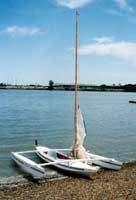 |
The symmetry and graceful shape, almost organic, won me over completely.
|
|
Finding a plan for a small basic trimaran was easier said than done. My effort on the web proved fruitless as I had set a criteria for what type of craft I needed and this was also a problem. As I had not enough space at home for a boat trailer, the craft had to be modular for easy assembly and lightweight enough for me to be able to lift it up atop my panel van.
Eventually, a visit to Bayside Wooden Boats and a chat to Ross Lillistone brought results. He suggested that I check out an American website called Duckworks Magazine and have a look at something called a Trilars. This craft was designed by Jim Michalak and turned out to be a 16ft. kayak that had been redesigned with outriggers added to become a small trimaran. This was exactly what I wanted because with my kayak building experience, I saw the construction of this as just three kayaks joined together.
| This craft was designed by Jim Michalak and turned out to be a 16ft. kayak that had been redesigned with outriggers added to become a small trimaran. |
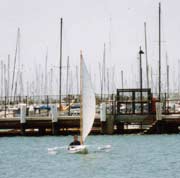
|
|
A couple of weeks and a couple of emails later saw me in possession of the plans for the Trilars, which, after due thought and obvious Aussie logic, I named mine the Trikye.
In the construction I deviated slightly from the original design where Jim had suggested a leeboard for the starboard side, I built in a pivoting drop centreboard which kicks back admirably in the sometimes shallow waters of the bay. The other reason for doing away with the leeboard was because I wanted to keep the sides of the main hull clear for paddling. I find it great to be able to paddle away from the ramp or beach before I hoist the sail or drop the centreboard, and the same goes for coming in or maneuvering anywhere.
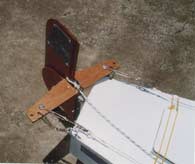 |
One other thing that I changed was the rudder control. I wanted more freedom for my hands.
|
|
One other thing that I changed was the rudder control. I wanted more freedom for my hands so I designed and built foot pedals joined to the rudder arms by stainless steel cables. Now I can set the sails, steer with my feet, and enjoy my glass of wine.
The assembly of the Trikye is simplicity itself. Thirty minutes after arrival at the waters edge, I can be sailing away. With the main hull on the ground, the two cross arms are bolted on with four stainless steel bolts and wingnuts. The outrigger floats are then placed in position and bolted on with two stainless steel bolts and wingnuts each fore and aft. The rudder is dropped into the pintles, secured with a locking pin, and the raising and lowering rope threaded through to the cockpit.
The free standing laminated pine mast gets dropped in, the boom lowered, all sheets and halyard attached and she is ready to go.
The plans that Jim Michalak sent me included the shape and dimensions for a sail. It was then that I remembered the set of sails for the Hartley 16.
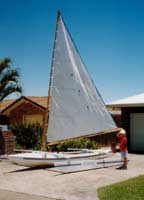 |
The free standing laminated pine mast gets dropped in, the boom lowered, all sheets and halyard attached and she is ready to go.
|
|
The sail plans seemed somehow familiar and it turned out that the jib from the Hartley was almost identical to Jim's sail plan, in reverse, that is. So I merely turned the sail around, made the luff the leach, trimmed a bit off the foot, and had a no cost rig.
Finally, where the modular Trikye really shines is when I arrive at a particular beach, I can lift out the mast and unscrew four bolts and remove the outrigger assembly. I then have a 16ft. kayak to paddle around and explore the shallow areas or a creek. When I am ready to sail home, I drop the outriggers into position, fit the four bolts, pop in the mast and in ten minutes I'm sailing away.
| I designed and built foot pedals joined to the rudder arms by stainless steel cables. |
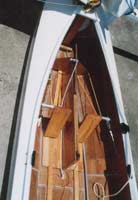
|
|
On the sailing performance side of the story, this craft is incredibly stable. Much more than I ever hoped for in such a small trimaran. Her speed, even with my inexperience seems quite fast. Moreton Bay tends to get a bit choppy with a 10/15 knot nor-easterly blowing and a moderate swell, but the Trikye cuts through the tops of the whitecaps like a ballet dancer on point.
The only minor problem that presented itself was that when I sailed into a leading wind with a fair chop, the spray tended to curve up from the bow and things got a bit wet. I solved that problem by making a spray skirt out of some shadecloth and attached it at three points at the bow, the crossarms and the sides. This, in turn, really gives the Trikye the form of a manta ray in flight.
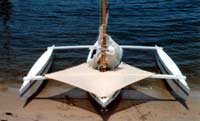 |
I made a spray skirt out of some shadecloth and attached it at three points at the bow, the crossarms and the sides.
|
|
My small craft has now been built and sailed. I learned to sail her the hard way; maybe not the smart way; but you sure learn a lot from your mistakes, and fast. Now for the larger one, big sister to the Trikye.

|